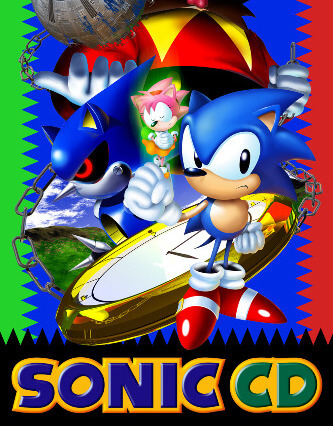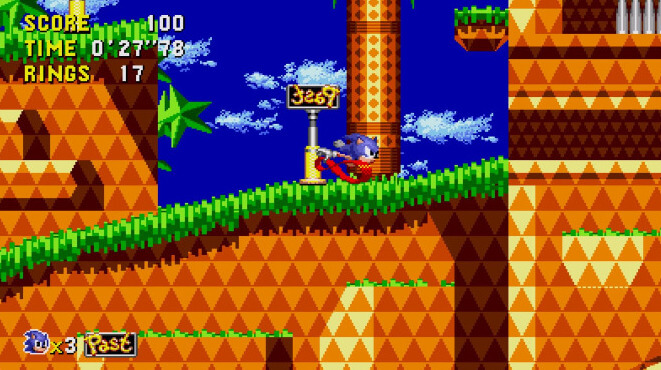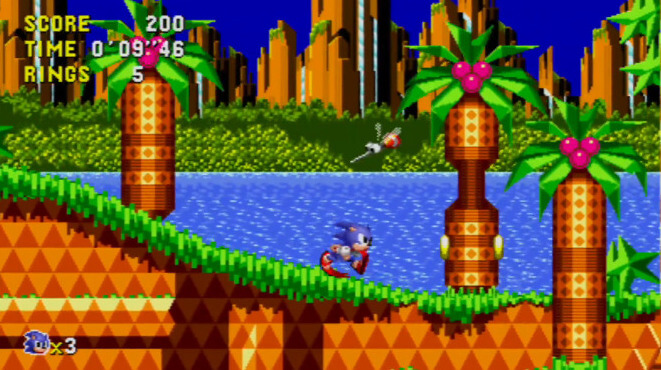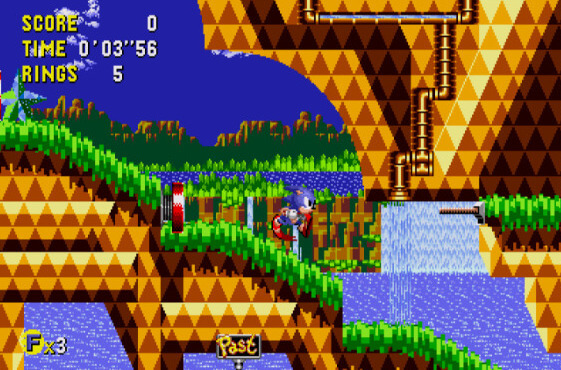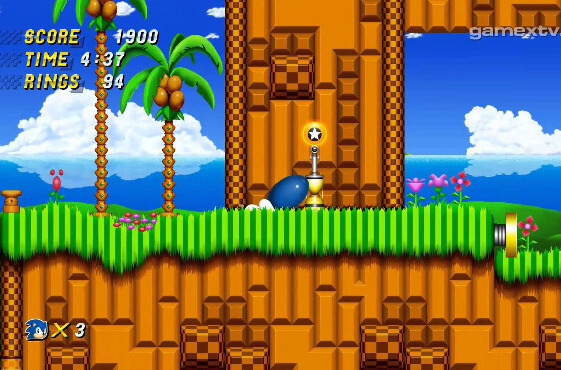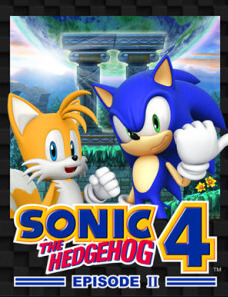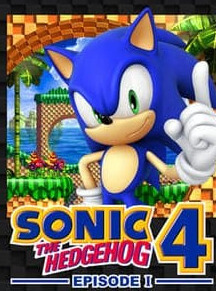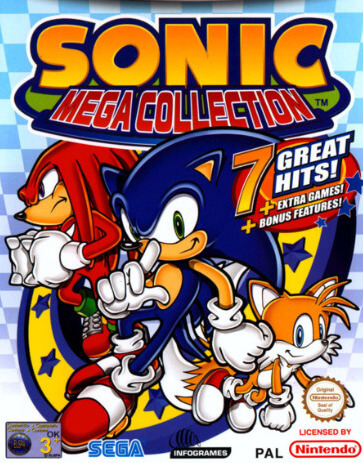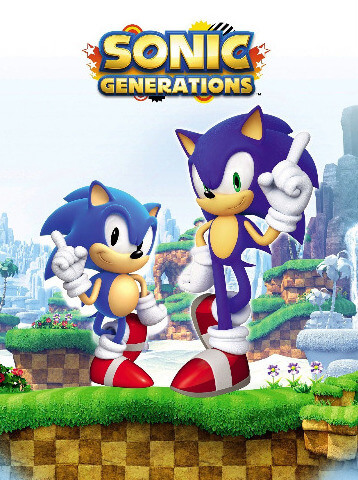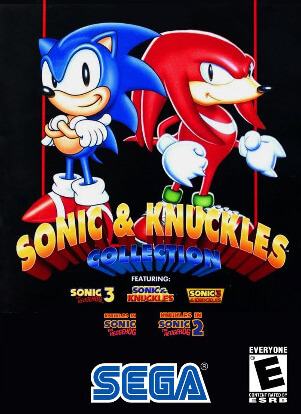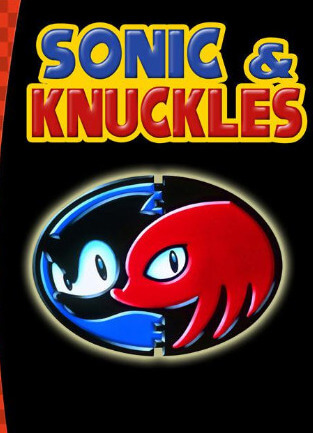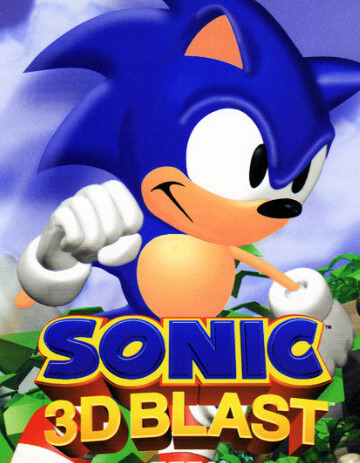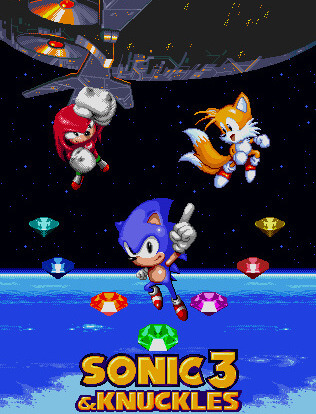Sonic CD is a side-scrolling platform game similar to the original Sonic the Hedgehog. Players control Sonic the Hedgehog as he ventures to stop his nemesis Doctor Robotnik from obtaining the magical Time Stones and conquering Little Planet. Like previous games, Sonic can destroy enemies and objects (such as certain walls and television monitors containing power-ups) by rolling into a ball, and collects rings as a form of health. Sonic can also perform a "spin dash" and a "super peel-out" that can increase his speed. The game is split into seven levels called rounds; each round is split into three zones, the third of which culminates in a boss fight with Robotnik. Players start with three lives, which are lost when they suffer any type of damage without rings in their possession; losing all lives results in a game over.
Sonic CD is differentiated from other Sonic games through its time travel game mechanic, which allows players to access different versions of stages set in the past, present and future. Sonic starts the first two zones in the present, and can travel through time by hitting signs labelled "past" or "future" and maintaining speed for several seconds. By default, future stages depict neglect and decay after Robotnik has conquered Little Planet. Players are encouraged to convert each zone into a "good future", with bright colors, no enemies, and few obstacles. To achieve a good future in each zone, players must travel to the past—a primitive, overgrown landscape—and destroy a hidden transporter where enemy robots spawn. The third zone is always set in the future, its timeline dependent upon whether the player destroyed both transporters.
By finishing a level with more than 50 rings, Sonic can access a special stage, in which he must destroy six UFOs in a pseudo-3D environment within a time limit. Time is reduced swiftly if the player runs through water, though a special UFO which appears when time is running out grants extra time if destroyed. If the player destroys all the UFOs before the time runs out, they earn a Time Stone. Collecting all seven Time Stones, or achieving a "good future" in every zone, unlocks the best possible ending. The game also features a time attack mode, where players can replay completed levels in the fastest time possible; a "D.A. Garden", where players can listen to the music of completed zones; and a "Visual Mode", where players can view the opening and closing animations. The game also includes a save feature, which uses the back-up memory of the Sega CD.:20
Plot
Sonic journeys to Never Lake, where an extraterrestrial body, Little Planet, appears on the last month of every year. Sonic's nemesis Dr. Robotnik has tethered the planet to a mountain and begun transforming it into a giant fortress with his robot army. Robotnik seeks the Time Stones, seven jewels capable of altering the passage of time. Sonic ventures into the planet, followed by the besotted Amy Rose, his self-proclaimed girlfriend. Robotnik dispatches his top robotic enforcer, Metal Sonic, who kidnaps Amy to lure Sonic into danger. Sonic clashes with Robotnik and Metal Sonic and uses time travel to stop Robotnik and save Amy.
After racing and defeating Metal Sonic in Stardust Speedway and saving Amy, Sonic fights and defeats Robotnik in his base. Two endings exist, depending on whether or not the player collected the Time Stones or achieved a good future in each level. In one ending, Little Planet is returned to its rightful state and leaves Never Lake; in the other, Little Planet leaves Never Lake, but Robotnik uses the Time Stones to retake it. When the planet reappears at the lake, Sonic returns, determined to save it.
Reception
Sonic CD received critical acclaim. The Sega CD version sold more than 1.5 million copies, making it the system's bestseller.
The presentation, visuals, and audio were praised. Computer and Video Games wrote that, although Sonic CD did not use the Sega CD's capabilities to its fullest, the game's graphics and sound were still excellent, calling the music "from the likes of 2Unlimited and Bizarre Inc". Electronic Games said that the game looked similar to older games and used the Sega CD's special features minimally, but this did not detract from the quality. The music was singled out as making Sonic CD "stand above the crowd"; the reviewer wrote that it helped add richness to the game. The reviewers of Electronic Gaming Monthly (EGM) praised the game's animated cinematics and sound, but noted frame rate drops during special stages. Retrospective opinions of the presentation have also been positive. IGN praised its vibrant colors and felt the game looked nice, and GamesRadar thought its music stood the test of time, writing: "What must've dated very quickly in the 1990s is somehow totally fresh today."
However, some critics were divided over the change of soundtrack between the international and North American versions. GameFan, which had given the Japanese version a highly positive review, lambasted the change of soundtrack when Sonic CD was released in America. GameFan editor Dave Halverson called the change "an atrocity that remains the biggest injustice in localization history". The reviewer for GamesRadar claimed to have shut his GameCube off in disgust when he realized Sonic Gems Collection used the American soundtrack. In a 2008 interview, Nilsen said "I think critics were looking for a way to bash the game... it was like we replaced the music for Star Wars after the movie had been out for a while".
